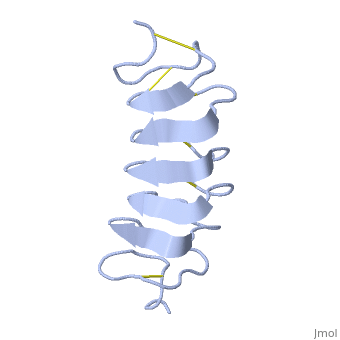Tenebrio molitor Antifreeze Protein (TmAFP)
From Proteopedia
(Difference between revisions)
| Line 1: | Line 1: | ||
| - | |||
<StructureSection load='1l1i' size='340' side='right' caption='Yellow mealworm antifreeze protein NMR structure (PDB code [[1l1i]]).' scene=''> | <StructureSection load='1l1i' size='340' side='right' caption='Yellow mealworm antifreeze protein NMR structure (PDB code [[1l1i]]).' scene=''> | ||
| - | + | __TOC__ | |
''Tm''AFP is an hyperactive antifreeze protein and its origin is the Tenebrio Mollitor beetle.Due to ''Tm''AFP, Tenebrio Mollitor beetle has resistance against freezing - provides protection against physical and osmotic stresses. | ''Tm''AFP is an hyperactive antifreeze protein and its origin is the Tenebrio Mollitor beetle.Due to ''Tm''AFP, Tenebrio Mollitor beetle has resistance against freezing - provides protection against physical and osmotic stresses. | ||
The protein consists of 84 amino acids and the molecular weight is 8.4 kDA. | The protein consists of 84 amino acids and the molecular weight is 8.4 kDA. | ||
| Line 17: | Line 16: | ||
| - | + | <ref>DOI 10.1016/S0968-0004</ref> | |
| - | + | ||
| - | + | ||
| - | + | ||
== Function == | == Function == | ||
| Line 47: | Line 43: | ||
== Structural highlights == | == Structural highlights == | ||
| - | + | ==3D structures of antifreeze protein== | |
| + | [[Antifreeze protein]] | ||
</StructureSection> | </StructureSection> | ||
== References == | == References == | ||
<references/> | <references/> | ||
Revision as of 09:33, 1 January 2015
| |||||||||||
References
- ↑ Liou YC, Tocilj A, Davies PL, Jia Z. Mimicry of ice structure by surface hydroxyls and water of a beta-helix antifreeze protein. Nature. 2000 Jul 20;406(6793):322-4. PMID:10917536 doi:10.1038/35018604
- ↑ Mitochondria as we don't know them. Tielens, Aloysius G.M et al. Trends in Biochemical Sciences , Volume 27 , Issue 11 , 564 - 572 doi:10.1016/S0968-0004(02)02193-X
- ↑ Liou YC, Tocilj A, Davies PL, Jia Z. Mimicry of ice structure by surface hydroxyls and water of a beta-helix antifreeze protein. Nature. 2000 Jul 20;406(6793):322-4. PMID:10917536 doi:10.1038/35018604

